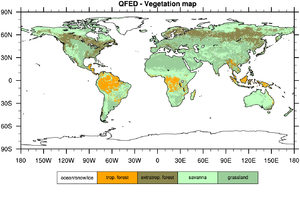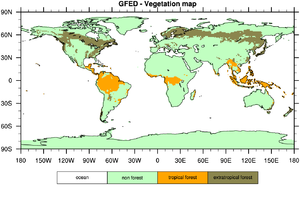Quick Fire Emission Dataset (QFED): Difference between revisions
| Line 50: | Line 50: | ||
== QFED Vegetation Map == | == QFED Vegetation Map == | ||
The QFED vegetation classes are Tropical Forest, Extratropical Forest, Savanna and Grassland. The QFED vegetation map is derived from the global IGBP land cover data set by aggregating one or more IGBP classes into a single QFED class. QFED Tropical Forest corresponds to IGBP Evergreen Broadleaf for latitudes (30°S, 30°N), whereas QFED Extratropical Forest includes the rest of the IGBP forest types and IGBP Evergreen Broadleaf for latitudes outside the (30°S, 30°N) zone. | The QFED vegetation classes are Tropical Forest, Extratropical Forest, Savanna and Grassland. The QFED vegetation map is derived from the global IGBP land cover data set by aggregating one or more IGBP classes into a single QFED class. QFED Tropical Forest corresponds to IGBP Evergreen Broadleaf for latitudes (30°S, 30°N), whereas QFED Extratropical Forest includes the rest of the IGBP forest types and IGBP Evergreen Broadleaf for latitudes outside the (30°S, 30°N) zone. The IGBP shrubland and savanna classes are aggregated into the QFED Savanna class. Similarly, the IGBP grassland and cropland classes are aggregated into the QFED Grassland class. | ||
The QFED vegetation map uses the following numerical values for the vegetation classes: | The QFED vegetation map uses the following numerical values for the vegetation classes: | ||
| Line 62: | Line 62: | ||
| [[Image:GFED-vegetation_map.png|thumb|center|alt=GFED vegetation map.|GFED vegetation map.]] | | [[Image:GFED-vegetation_map.png|thumb|center|alt=GFED vegetation map.|GFED vegetation map.]] | ||
|} | |} | ||
== Level 3 QFED Products == | == Level 3 QFED Products == | ||
Revision as of 04:48, 8 June 2010
This page to contains information regarding QFED, mostly for developers.
How to Check Out and Build the Code
These are checkout and build instructions for QFED. We presume that the user has an account and appropriate permissions on progress to check code out, and access to the NCCS machines (e.g., discover) to run code.
The name of the module in the cvs repository is QFED. Currently the name of the development tag is qfed-1_0_b4. To checkout the QFED source into the directory ./qfed/src, for example, use the following command
% cvs -d $CVSROOT co -d ./qfed/src -r qfed-1_0_b4 QFED
Once the code is checked out set the ESMADIR variable to point to the QFED top directory, e.g.:
% setenv ESMADIR ${HOME}/projects/qfed
Make sure that you have a valid ${BASEDIR}. QFED code is known to compile against Baselibs-v3.1.7.
To build the code navigate to the source directory where you will find the main GNUMakefile:
% cd ./qfed/src
The available options can be seen by running gmake or gmake esma_help:
% gmake esma_help
Standard ESMA targets:
% make esma_install (builds and install under ESMADIR)
% make esma_clean (removes deliverables: *.[aox], etc)
% make esma_distclean (leaves in the same state as cvs co)
% make esma_doc (generates PDF, installs under ESMADIR)
% make esma_help (this message)
Environment:
ESMADIR = .../qfed/src/
BASEDIR = /opt/Baselibs/v3.1.7/
ARCH = Linux
SITE = hostname
To build and install QFED :
% make esma_install
followed by
% make PYTHON_INSTALL=python_install install
if you wish to install the python modules and scripts as well.
QFED Vegetation Map
The QFED vegetation classes are Tropical Forest, Extratropical Forest, Savanna and Grassland. The QFED vegetation map is derived from the global IGBP land cover data set by aggregating one or more IGBP classes into a single QFED class. QFED Tropical Forest corresponds to IGBP Evergreen Broadleaf for latitudes (30°S, 30°N), whereas QFED Extratropical Forest includes the rest of the IGBP forest types and IGBP Evergreen Broadleaf for latitudes outside the (30°S, 30°N) zone. The IGBP shrubland and savanna classes are aggregated into the QFED Savanna class. Similarly, the IGBP grassland and cropland classes are aggregated into the QFED Grassland class.
The QFED vegetation map uses the following numerical values for the vegetation classes:
Tropical Forest = 1 Extratropical Forest = 2 Savanna = 3 Grassland = 4
 |
 |
Level 3 QFED Products
There are two Level 3 (Global Gridded) QFED products:
- The daily fire radiative power (FRP) derived from MODIS Thermal Anomalies/Fire products (MOD14, MYD14). The name of the product is QFED Level 3a.
- Level 3b is the daily fire CO emissions for each QFED vegetation class. The Level 3b product is derived from the Level 3a product. The name of this product is QFED Level 3b.
The QFED Level 3a product can be generated after obtaining the necessary MOD14 and/or MYD14 granules using the qfed_l3a.py script. Similarly, Level 3b can be generated using the qfed_l3b.py script. Typical usage of the scripts will require one to provide the year and start and end day of the year. For full list of options run the scripts with the '--help' option, e.g.
% qfed_l3a.py --help